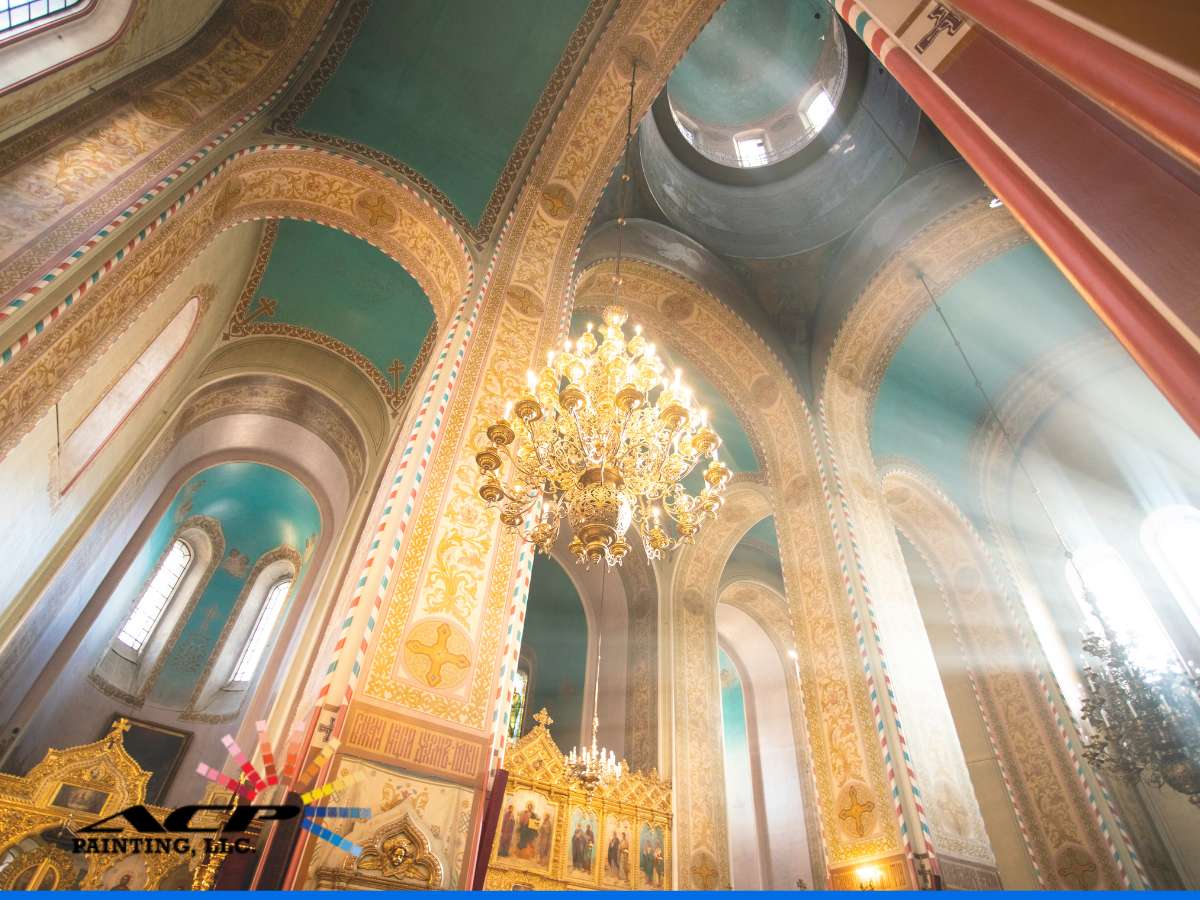Essential Tips For Selecting Churches & Temples Interior Color Schemes
Choosing paint colors for a church can be tricky, especially with so many colors on the market. You probably want to set the proper tone for prayer and reflection, not otherwise. But how do you choose colors that honor both tradition and beauty?
That’s where thoughtful planning—and guidance from experienced painting contractors—comes in. In this article, we’ll explore the key elements to consider when selecting interior colors for churches and temples so you can create a space that feels sacred and welcoming.

Best Paint Colors For Church & Temple Interiors
When choosing the best colors for a church or temple, you have to focus less on following trends and more on creating a timeless, reverent, and welcoming space. The colors you choose should support the spiritual purpose while also complementing the place’s architectural features and any stained glass or symbolic artwork. Professionals with experience in commercial interior painting can help ensure that these sacred spaces are enhanced with the right tones and finishes for both beauty and durability.
Here’s a breakdown of the most recommended colors and what they bring to sacred interiors:
Neutral Colors: Calm & Classic
Soft grays, beiges, and pale yellows are excellent options to create a peaceful, meditative atmosphere. These colors are especially effective as a backdrop, allowing stained glass or symbolic art to stand out.
Violet: Royalty & Reverence
Violet is traditionally associated with royalty and can represent Christ’s kingly office. It’s best used as an accent (on pews, carpeting, or decorative banners), since overuse can feel heavy. Lighter shades of violet bring a soft, contemplative mood without overwhelming the space.
Blue: Faith & Trust
Blue evokes feelings of trust, peace, and reflection. It’s becoming increasingly popular in Protestant churches, where it also works well as a branding color. Use blue on walls or furnishings to inspire a sense of calm and spiritual grounding.
Red: Spirit & Strength
Red symbolizes the Holy Spirit and brings energy, passion, and love into a worship space. It shines in upholstery or carpets but should be balanced with softer tones, as it naturally draws attention and can dominate if overused.
Green: Growth & Renewal
Green represents life, renewal, and harmony, making it a natural fit for spaces focused on community and growth. A green accent wall or plant-inspired décor can make the space feel grounded and hopeful.
Orange & Gold: Joy & Wisdom
Orange can uplift the spirit, symbolizing joy and sunshine. Gold adds a sense of divine wisdom and warmth. These are best used sparingly (such as for trim, artwork details, or lighting accents) to enrich the palette without overwhelming it.
Important Considerations For Painting a Church Or Temple Interior
Understand The Purpose Of The Space
Before finding a color palette, reflect on how the space is used. Is it primarily for worship and prayer? Community gatherings? Ceremonial rites? Each function carries its own tone.
Sacred spaces used for quiet reflection might benefit from calming hues like soft blues or earth tones, while larger, multi-purpose spaces may require a more neutral base that can adapt to different events.
Always prioritize colors that support the space’s spiritual function and allow worshippers to focus inward.
Respect Religious & Cultural Symbolism.
Color carries deep significance in many faiths. For example, gold and white in Christianity symbolize divinity and purity, while red can represent the Holy Spirit. But in other religions, such as Hindu temples, vibrant colors like saffron and marigold are often associated with sacredness and celebration.
That’s why you must research and respect the traditional color associations of the specific religion for the church or temple you’re working on. Avoid colors that might be unintentionally inappropriate or misinterpreted by the community.
Consider The Emotional & Psychological Impact
Color psychology plays a subtle but powerful role in how people feel in a space. Cool tones like blues and greens are known for their calming effects, and warm hues like amber or soft terracotta can create a sense of warmth and belonging.
Like we mentioned earlier in this post, you should research the psychological impact of the potential colors you’ll choose for the church. This way, you’ll paint the temple wisely and without compromising its atmosphere.
Evaluate Natural Light & Architecture
Before rushing into the right church wall color, it’s better to spend time walking around your church’s interior to know its details. Make note of any architectural structures, light fixtures, special structures, and so on.
The balance between color, light, and architecture is a crucial aspect for sacred settings. Natural light shifts throughout the day and can dramatically alter how colors appear. Stained-glass windows may cast tinted light that interacts uniquely with certain hues. High ceilings, archways, and alcoves also influence how color travels across surfaces.
We recommend testing swatches under real lighting conditions before finalizing decisions, and don’t forget to consider finishes (matte, satin, or gloss) as they affect reflectivity and mood.
Balance Aesthetic Appeal With Timelessness
Trends come and go, but spiritual spaces often stand for decades—even centuries!
Choose a palette that feels fresh yet enduring. For example, muted or neutral base tones with subtle accent colors often provide a timeless backdrop that won’t feel dated.
Think in terms of harmony and restraint rather than dramatic contrasts. The goal is to create an atmosphere that remains beautiful and meaningful across generations.
Incorporate Flexibility For Seasonal Changes
Religious spaces often change their decor based on seasonal observances (Lent, Easter, Diwali, Hanukkah, etc.)
Opt for a foundational color scheme that allows for temporary overlays like banners, flowers, or special clothes in seasonal tones. Neutral walls or natural wood tones pair well with vibrant liturgical or ceremonial fabrics, providing versatility without frequent repainting.
Collaborate With Religious Leaders and Painting Experts For Best Results
We strongly advise avoiding making color decisions all by yourself. Feel free to ask for advice, especially from clergy, congregation members, or temple elders. They’re the best people who understand preferences, traditions, and sensitivities.
A collaborative approach builds trust and ensures the outcome is embraced. Consulting with architects, interior designers, and professional painting contractors experienced in religious or residential interior painting projects can also be invaluable because they can help balance symbolism, psychology, and practical needs with a refined visual outcome.
Hire Trusted Church & Temple Painting Contractors In Maricopa
If you’re looking for expert Maricopa painting contractors who bring your vision to life, ACP Painting is ready to help! We specialize in high-quality interior painting that appeals to religious spaces. With deep respect for sacred architecture and years of professional experience, ACP Painting can help you create an interior that’s both reverent and radiant. Contact us now for more help!

Maricopa
20987 N John Wayne Pkwy
Maricopa, AZ 85139
Phone: 480-785-6323
Scottsdale
8350 E Raintree Dr Ste 215,
Scottsdale, AZ 85260
Phone: 480- 764-3735



